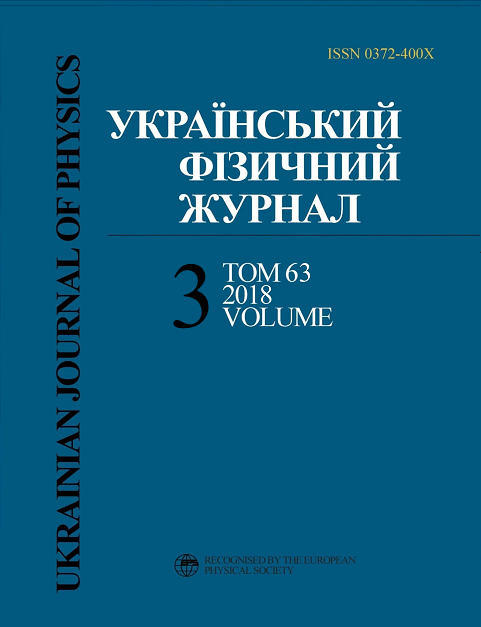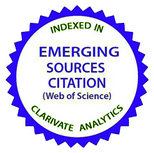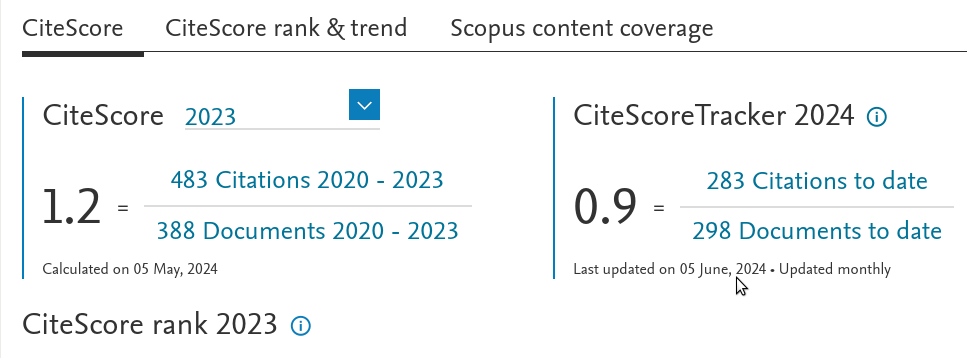Оптичні властивості провідного полімеру полі(O-толуїдин)-ДБСК, змішаного з оксидом поліетилену
DOI:
https://doi.org/10.15407/ujpe63.3.263Анотація
Провiдний полiмер полi(O-толуїдин) (ПIТ), легований додецил бензол сульфоновою кислотою (ДБСК), було приготовано хiмiчною полiмеризацiєю за допомогою персульфата амонiю (NH4)2S2O8 як окислювача. Цей полiмер змiшувався з полiоксидом етилену (ПВЕ) в рiзних вагових спiввiдношеннях (0%, 10%, 15%, 25%, 35%, 45%, 50%) для отримання методом центрифугування провiдної наносумiшi ПОТ-ДБСК/ПВЕ, яка наносилася на пiдкладку зi скла. Морфологiю поверхнi дослiджено методом растрової електронної мiкроскопiї. Оптичнi властивостi плiвки вивченi за спектрами поглинання на довжинах хвиль 300–1100 нм. Аналiз оптичних даних показує прямий перехiд зi зменшенням ширини забороненої зони з 2,80 еВ до 2,25 еВ при збiльшеннi вмiсту ПВЕ вiд 0% до 50%.
Посилання
<li>P.-C. Wang, et al. Transparent electrodes based on conducting polymers for display applications. Displays 34 (4), 301 (2013).
<a href="https://doi.org/10.1016/j.displa.2013.05.003">https://doi.org/10.1016/j.displa.2013.05.003</a>
</li>
<li>M. Jaymand. Recent progress in chemical modification of polyaniline. Progress in Polymer Science 38 (9), 1287 (2013).
<a href="https://doi.org/10.1016/j.progpolymsci.2013.05.015">https://doi.org/10.1016/j.progpolymsci.2013.05.015</a>
</li>
<li>X. Guo, M. Baumgarten, K. M?ullen. Designing п-conjugated polymers for organic electronics. Progress in Polymer Science 38 (12), 1832 (2013).
<a href="https://doi.org/10.1016/j.progpolymsci.2013.09.005">https://doi.org/10.1016/j.progpolymsci.2013.09.005</a>
</li>
<li>Y. Zhao, S. Si, C. Liao. A single flow zinc//polyaniline suspension rechargeable battery. J. Power Sources 241, 449 (2013).
<a href="https://doi.org/10.1016/j.jpowsour.2013.04.095">https://doi.org/10.1016/j.jpowsour.2013.04.095</a>
</li>
<li>L. Wang et al. Graphene sheets, polyaniline and AuNPs based DNA sensor for electrochemical determination of BCR/ABL fusion gene with functional hairpin probe. Biosensors and Bioelectronics 51, 201 (2014).
<a href="https://doi.org/10.1016/j.bios.2013.07.049">https://doi.org/10.1016/j.bios.2013.07.049</a>
</li>
<li>G. Gupta et al. Polyaniline-lignosulfonate/epoxy coating for corrosion protection of AA2024-T3. Corrosion Science 67, 256 (2013).
<a href="https://doi.org/10.1016/j.corsci.2012.10.022">https://doi.org/10.1016/j.corsci.2012.10.022</a>
</li>
<li>A.R. Elkais et al. The influence of thin benzoate-doped polyaniline coatings on corrosion protection of mild steel in different environments. Progress in Organic Coatings 76(4), 670 (2013).
<a href="https://doi.org/10.1016/j.porgcoat.2012.12.008">https://doi.org/10.1016/j.porgcoat.2012.12.008</a>
</li>
<li>P.L. Burn, S.C. Lo, I.D. Samuel. The development of light-emitting dendrimers for displays. Advanced Materials 19 (13), 1675 (2007).
<a href="https://doi.org/10.1002/adma.200601592">https://doi.org/10.1002/adma.200601592</a>
</li>
<li>S. Nam et al. Solvent-free solution processed passivation layer for improved long-term stability of organic field-effect transistors. J. Mater. Chem. 21 (3), 775 (2011).
<a href="https://doi.org/10.1039/C0JM00898B">https://doi.org/10.1039/C0JM00898B</a>
</li>
<li> K. Ziadan, H. Hussein, K. Ajeel. Study of the electrical characteristics of poly (o-toluidine) and application in solar cell. Energy Procedia 18, 157 (2012).
<a href="https://doi.org/10.1016/j.egypro.2012.05.027">https://doi.org/10.1016/j.egypro.2012.05.027</a>
</li>
<li> E.L.Williams et al. Conducting polymer and hydrogenated amorphous silicon hybrid solar cells. Appl. Phys. Lett. 87 (22), 223504 (2005).
<a href="https://doi.org/10.1063/1.2136409">https://doi.org/10.1063/1.2136409</a>
</li>
<li> P.-J. Alet et al. Hybrid solar cells based on thin-film silicon and P3HT-A first step towards nano-structured devices. Europ. Phys. J. Appl. Phys. 36 (3), 231 (2006).
<a href="https://doi.org/10.1051/epjap:2006145">https://doi.org/10.1051/epjap:2006145</a>
</li>
<li> N. Gospodinova, L. Terlemezyan. Conducting polymers prepared by oxidative polymerization: polyaniline. Progress in Polymer Science 23 (8), 1443 (1998).
<a href="https://doi.org/10.1016/S0079-6700(98)00008-2">https://doi.org/10.1016/S0079-6700(98)00008-2</a>
</li>
<li> K. Gurunathan et al. Electrochemically synthesised conducting polymeric materials for applications towards technology in electronics, optoelectronics and energy storage devices. Mater. Chem. Phys. 61 (3), 173 (1999).
<a href="https://doi.org/10.1016/S0254-0584(99)00081-4">https://doi.org/10.1016/S0254-0584(99)00081-4</a>
</li>
<li> A.J. Heeger. Polyaniline with surfactant counterions: Conducting polymer materials which are processible in the conducting form. Synthetic Metals 57 (1), 3471 (1993).
<a href="https://doi.org/10.1016/0379-6779(93)90462-6">https://doi.org/10.1016/0379-6779(93)90462-6</a>
</li>
<li> Y. Kang, M.-H. Lee, S.B. Rhee. Electrochemical properties of polyaniline doped with poly (styrenesulfonic acid). Synthetic Metals 52 (3), 319 (1992).
<a href="https://doi.org/10.1016/0379-6779(92)90031-D">https://doi.org/10.1016/0379-6779(92)90031-D</a>
</li>
<li> A. Elmansouri et al. Spectroscopic characterization of electrodeposited poly(o-toluidine) thin films and electrical properties of ITO/poly(o-toluidine)/aluminum schottky diodes. Active and Passive Electronic Components 2007, 7 (2007).
<a href="https://doi.org/10.1155/2007/17846">https://doi.org/10.1155/2007/17846</a>
</li>
<li> M.Z. Kareema, F. Hussein. K.I. Ajeel. Study of the electrical characteristics of poly(o-toluidine) doped with paratoluene sulphonic acid/n-type silicon heterojunction solar cells. In: 2nd international conference on solar energy materials (solar Asia 2013) 22–24 Ague, Universiti Malaya, 50603, Kuala Lumpur. Malaysia 250 (2013).
</li>
<li> M. Kareema, W.T.S. Ziadan. Study of the electrical characteristics of polyaniline prepared electrochemical polymerization (Energy procedia, 2012).
</li>
<li> W. Pan, Q. Zhang, Y. Chen. Characterization of PAN/PANI-DBSA blend nanofibers produced by electrospinning method. Optoelectron Adv. Mater Rapid Commun. 4, 2118 (2010).
</li>
<li> T.J. Alwan, K.M. Ziadan, K.K. Kadhum. Alignment Nanofibers Conducting Polymer (PAni. CSA/PEO) Preparation by Electrospinning Technique. Intern. Review Phys. (IREPHY) 7(2), 185 (2013).
</li>
<li> J.M. Deitzel et al. The effect of processing variables on the morphology of electrospun nanofibers and textiles. Polymer 42 (1), 261 (2001).
<a href="https://doi.org/10.1016/S0032-3861(00)00250-0">https://doi.org/10.1016/S0032-3861(00)00250-0</a>
</li>
<li> A. Elmansouri et al. Spectroscopic characterization of electrodeposited poly (o-toluidine) thin films and electrical properties of ITO/poly (o-toluidine)/aluminum Schottky diodes (Active and Passive Electronic Components, 2007).
<a href="https://doi.org/10.1155/2007/17846">https://doi.org/10.1155/2007/17846</a>
</li>
<li> Y. Ramadin et al. Optical properties of epoxy-glass mi- croballoons composite. Optical Materials 5 (1–2), 69 (1996).
<a href="https://doi.org/10.1016/0925-3467(95)00033-X">https://doi.org/10.1016/0925-3467(95)00033-X</a>
</li>
<li> F. Al-Eithan, M. Al-Edani, A. Abass. Optical Band of Triglycine Selenate (TGSe) Single Crystals. Phys. Status Solidi A 103(2), 571 (1987).
<a href="https://doi.org/10.1002/pssa.2211030230">https://doi.org/10.1002/pssa.2211030230</a>
</li>
<li> M.R. Safenaz, M. Sheikha. Synthesis and electrical properties of polyaniline composite with silver nanoparticles (Advances in Materials Physics and Chemistry, 2012).
</li></ol>
##submission.downloads##
Опубліковано
Як цитувати
Номер
Розділ
Ліцензія
Ліцензійний Договір
на використання Твору
м. Київ, Україна
Відповідальний автор та співавтори (надалі іменовані як Автор(и)) статті, яку він (вони) подають до Українського фізичного журналу, (надалі іменована як Твір) з одного боку та Інститут теоретичної фізики імені М.М. Боголюбова НАН України в особі директора (надалі – Видавець) з іншого боку уклали даний Договір про таке:
1. Предмет договору.
Автор(и) надає(ють) Видавцю безоплатно невиключні права на використання Твору (наукового, технічного або іншого характеру) на умовах, визначених цим Договором.
2. Способи використання Твору.
2.1. Автор(и) надає(ють) Видавцю право на використання Твору таким чином:
2.1.1. Використовувати Твір шляхом його видання в Українському фізичному журналі (далі – Видання) мовою оригіналу та в перекладі на англійську (погоджений Автором(ами) і Видавцем примірник Твору, прийнятого до друку, є невід’ємною частиною Ліцензійного договору).
2.1.2. Переробляти, адаптувати або іншим чином змінювати Твір за погодженням з Автором(ами).
2.1.3. Перекладати Твір у випадку, коли Твір викладений іншою мовою, ніж мова, якою передбачена публікація у Виданні.
2.2. Якщо Автор(и) виявить(лять) бажання використовувати Твір в інший спосіб, як то публікувати перекладену версію Твору (окрім випадку, зазначеного в п. 2.1.3 цього Договору); розміщувати повністю або частково в мережі Інтернет; публікувати Твір в інших, у тому числі іноземних, виданнях; включати Твір як складову частину інших збірників, антологій, енциклопедій тощо, то Автор(и) мають отримати на це письмовий дозвіл від Видавця.
3. Територія використання.
Автор(и) надає(ють) Видавцю право на використання Твору способами, зазначеними у п.п. 2.1.1–2.1.3 цього Договору, на території України, а також право на розповсюдження Твору як невід’ємної складової частини Видання на території України та інших країн шляхом передплати, продажу та безоплатної передачі третій стороні.
4. Строк, на який надаються права.
4.1. Договір є чинним з дати підписання та діє протягом усього часу функціонування Видання.
5. Застереження.
5.1. Автор(и) заявляє(ють), що:
– він/вона є автором (співавтором) Твору;
– авторські права на даний Твір не передані іншій стороні;
– даний Твір не був раніше опублікований і не буде опублікований у будь-якому іншому виданні до публікації його Видавцем (див. також п. 2.2);
– Автор(и) не порушив(ли) права інтелектуальної власності інших осіб. Якщо у Творі наведені матеріали інших осіб за виключенням випадків цитування в обсязі, виправданому науковим, інформаційним або критичним характером Твору, використання таких матеріалів здійснене Автором(ами) з дотриманням норм міжнародного законодавства і законодавства України.
6. Реквізити і підписи сторін.
Видавець: Інститут теоретичної фізики імені М.М. Боголюбова НАН України.
Адреса: м. Київ, вул. Метрологічна 14-б.
Автор: Електронний підпис від імені та за погодження всіх співавторів.













